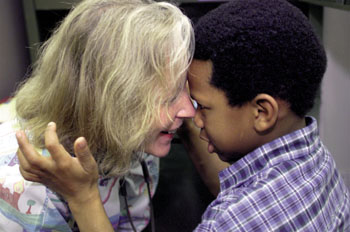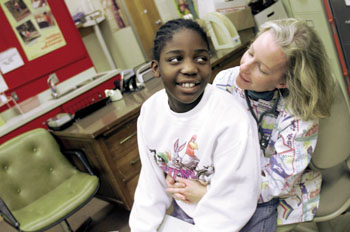
Second-grader Dontae Cook receives a hug and praise from school nurse Patti Scott. Dontae is one of hundreds of students seen at the Fall-Hamilton clinic. (photo by Dana Johnson)
VUSN school clinic embraces children

Fourth-grader Brianna Walton jokes with Scott during a visit to the school clinic. Scott works with other students like Brianna who require special care. (photo by Dana Johnson)
It’s 8 a.m. on Monday and Fall-Hamilton Elementary is abuzz.
It’s a typical day in one of Nashville’s schools: students scrambling to class; teachers beginning their lessons for the day; announcements blaring over the intercom system; and Patti Scott, RN.C, MSN, PNP, readying for her patients.
Since 1995, Vanderbilt University School of Nursing has operated a school-based health center at Fall-Hamilton focusing on the health care needs of the students and their families. Approximately 90 percent of the students live at or below the federal poverty level.
Each morning a contingent of students files into the center for daily medications. It’s hard for the students to contain their excitement as they call out for Miss Patti. Possibly construed as chaotic requests by many, it’s a chorus of voices to Scott.
“We have a steady number of students with scheduled medications and most are given twice daily. Most students come in for asthma-related treatments. Some are responsible for finding their own inhalers and beginning therapy only after completing education with me and being checked off on proper usage. I assess for asthma symptoms and see them again for the afternoon doses.”
But students get more than a routine dose of medication when they enter the health center. They come not just to see the nurse, but to visit a friend.
“I have a surprise for Miss Patti,” whispered Dontae Cook, a second-grader who receives daily asthma treatments.
Sure enough, as Scott listens to Dontae’s lungs there is no wheezing – a typical sign that treatment is not needed. He beams with pride and gives her a big hug.
“She is more than just a nurse,” smiled Dontae, 7. “She’s my friend.”
Like Dontae, every student who walks into the clinic clamors for Scott’s attention. At times, it’s harder persuading students to return to class than it is coaching them to take their medications. But one thing is for sure – students are careful not to overstep their bounds with Scott. They trust her.
“I’ve been here for six years,” Scott said. “I am the primary care provider for at least 80 students and their families. I’ve become the community nurse. These students know me. They feel safe with me. They are easy to love.”
For 24 years, Scott has been a pediatric nurse with 14 years spent in school health.
School-based health centers are not hubs for treating sickness and acute illnesses. They are a perfect vehicle to promote health education and awareness. Since starting this program, attendance rates are good. The number of ER visits is down and health care professionals are able to monitor the children and manage their illnesses.
A day at Fall-Hamilton’s health center begins with morning medications from 8 to 8:30; walk-in clinic from 8:30 to 11 a.m.; afternoon medications from 11 a.m. to 1 p.m.; and appointments for well-child exams, follow-up care, sport physicals and screenings from 1 to 3 p.m.
Clare Sullivan, RN.C, MSN, FNP, MPH, is coordinator of the school-based health centers for the Vanderbilt University School of Nursing. The program is also offered at Stratton Elementary, another Metro school serving an impoverished population of children and families.
Both locations have advanced practice nurses who are VUSN faculty who ensure that the centers are staffed. The health centers serve more than 1,000 children at both locations and have more than 5,000 visits a year.
“Every school needs a nursing presence, but not every school needs a clinic,” Sullivan said. “We are working on building acceptance in the community for school-based health centers. We are responsible for the primary health piece for children who are not insured or not going to a doctor.
“There are some hefty needs out there for high-risk families,” she said. “They may have access to a PCP, but they have trouble getting transportation. And then a lot of these families have so much going on – the system is not set up to support this population. For example, they may have an appointment, but the car breaks down or an uncle dies, or a cousin is shot. They forget about health care.
“They can’t take care of their children because their employer will not allow them to take off or if they don’t show up for work and they lose their job. What are they suppose to do?”
The services offered via the health centers are an example of the system working. It’s a collaborative effort among VUSN and various agencies throughout the city.
A year ago, Brianna Walton, a fourth-grader at Fall-Hamilton, was hospitalized for meningitis. Her foot was amputated due to the severity of the illness. She returned to school first in a wheelchair, then progressed to a walker. Now she has a prosthesis.
“Look, let me show you,” Brianna said. “I have a Titans cover on it. I come in so Miss Patti can check it. She is teaching me how to take care of it.”
Scott collaborated with a physical therapist to guide her through Brianna’s care.
“It really does take a village, but once the students and families feel secure, we can help ensure that their health care needs are being met,” Scott said.
“Parents are able to work because we are here. Children are able to come to school and do their work because we are here. Teachers are able to teach because we are here.
“Because we are able to handle the medical needs of these students, the system is working to benefit them and their families. It really makes a difference in those living in this community – both inside and outside the school building.”













